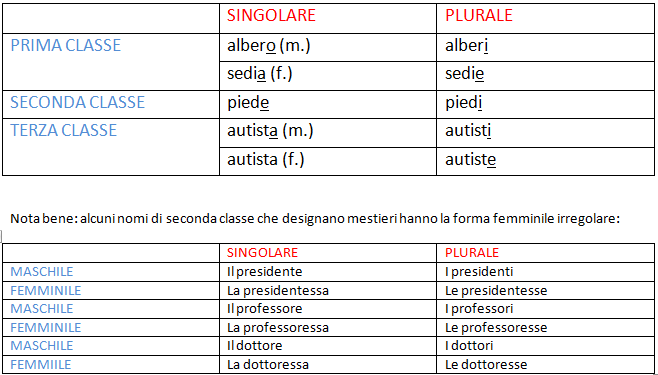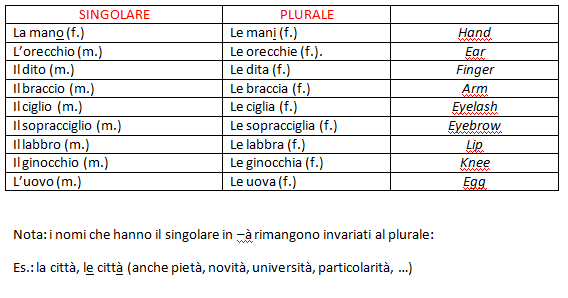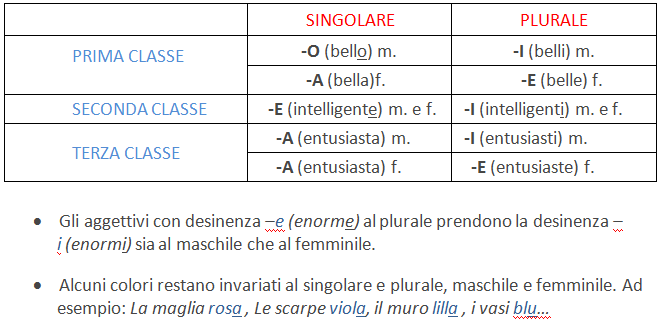NOUNS AND ADJECTIVES
SOSTANTIVI E AGGETTIVI
I SOSTANTIVI – NOUNS
I sostantivi italiani si dividono in tre classi.
La maggior parte dei sostantivi appartengono alla prima classe, in cui le desinenze del maschile e del femminile sono differenziate (il maschile ha desinenza in –O al singolare e in –I al plurale, mentre il femminile ha desinenza in –A al singolare e in –E al plurale).
Nel casi dei sostantivi di seconda classe, la desinenza del singolare è –E, mentre il plurale è –I. I sostantivi di terza classe hanno il singolare in –A e il plurale in –I (maschile) e in –E (femmile).
Italian nouns are divided in three categories.
Most nouns belong to the firs category, where masculine and feminine suffixes are distinguished (masculine suffix ends with an -O at the singular form, an -I at the plural form; while the feminine suffix ends with an -A at the singular form and an -E at the plural form).
The suffixes of second category nouns are: -E at the singular form, while -I at the plural form. Third category nouns end with an -A at the singular form and an -I (masculine) and an -E (feminine) at the plural form.
I sostantivi italiani si dividono in tre classi.
La maggior parte dei sostantivi appartengono alla prima classe, in cui le desinenze del maschile e del femminile sono differenziate (il maschile ha desinenza in –O al singolare e in –I al plurale, mentre il femminile ha desinenza in –A al singolare e in –E al plurale).
Nel casi dei sostantivi di seconda classe, la desinenza del singolare è –E, mentre il plurale è –I. I sostantivi di terza classe hanno il singolare in –A e il plurale in –I (maschile) e in –E (femmile).
Italian nouns are divided in three categories.
Most nouns belong to the firs category, where masculine and feminine suffixes are distinguished (masculine suffix ends with an -O at the singular form, an -I at the plural form; while the feminine suffix ends with an -A at the singular form and an -E at the plural form).
The suffixes of second category nouns are: -E at the singular form, while -I at the plural form. Third category nouns end with an -A at the singular form and an -I (masculine) and an -E (feminine) at the plural form.
Nota bene: alcuni sostantivi, specialmente quelli che designano parti del corpo, hanno delle desinenze irregolari e diventano femminili al plurale. Ad esempio:
Nota bene: some nouns, especially body parts, have irregular endings and they become feminine nouns at the plural form. For example:
Nota bene: some nouns, especially body parts, have irregular endings and they become feminine nouns at the plural form. For example:
Nota: le parole femminili con desinenza –I (es. oasi, ipotesi, tesi) non cambiano al plurale.
Note: feminine nouns ending with an -I (ex. oasi, ipotesi, tesi) don't change at the plural form.
AGGETTIVI- ADJECTIVES
Note: feminine nouns ending with an -I (ex. oasi, ipotesi, tesi) don't change at the plural form.
AGGETTIVI- ADJECTIVES
- Adjectives ending with -e (enorme) at the plural form they end with an -I, for both masculine and feminine nouns.
- Some colours remain unchanged at the singular and plural form, masculine and feminine. For example: pink shirt, purple shoes, lilliac wall, blue vases.
ESERCIZI - EXERCISES
A. Metti i sostantivi al plurale:
Change the following singular nouns to the plural:
1- La casa. Le ________ .
2- Il vestito. I _________ .
3- La luce. Le _________ .
4- La bambina. Le ________ .
5- Il fiume. I ________ .
6- La cantante. Le _________ .
7- Lo straniero. Gli __________ .
8- La matita. Le __________ .
B. Scegli l’aggettivo corretto:
Choose the right adjective:
1- Le bambine sono ______ . ( buona- buone- buoni)
2- Il gatto è ______ . ( nere- neri- nero)
3- La gonna è ______ . ( corta- corte- corto)
4- Il muro è ______ . ( rose – rosa- roso)
5- Gli occhi sono ______ . ( verde- verdo- verdi)
6- Le donne sono ______ . ( belle- bella- belli)
7- Il dottore è ______ . ( brava- bravo- brave)
8- La cantante è ______ . ( famose- famoso- famosa)
C. Metti le frasi al plurale:
Change the following singular sentences to the plural:
1- L’albero alto. Gli alberi alti .
2- La ragazza intelligente. _________________.
3- La gonna viola. _____________.
4- Il pesce crudo. _____________.
5- Il bambino basso. ______________.
6- La mela rossa. _____________.
7- Il signore elegante. ______________.
8- L’ombrello grande. _______________.
9- L’insegnante brava. ________________.
10- L’accendino blu. _________________.
SOLUZIONI- SOLUTIONS
Esercizio A: 1- case, 2- vestiti, 3- luci, 4- bambine, 5- fiumi, 6- cantanti, 7- stranieri,
8- matite.
Esercizio B: 1- buone, 2- nero, 3- corta, 4- rosa, 5- verdi, 6- belle, 7- bravo,
8- famosa.
Esercizio C: 2- Le ragazze intelligenti, 3- Le gonne viola, 4- I pesci crudi, 5- I bambini bassi, 6- Le mele rosse, 7- I signori eleganti, 8- Gli ombrelli grandi, 9- Le insegnanti brave, 10- Gli accendini blu.




